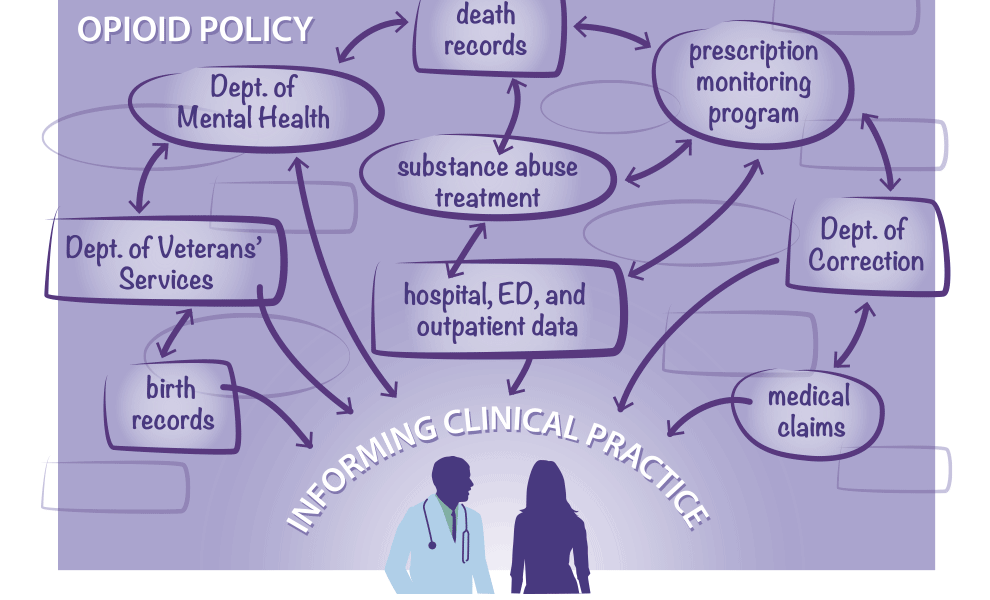By Brendan Abel, JD, MMS Legislative and Regulatory Affairs Counsel

Illustration by Chris Twichell
A stunning series of reports on the opioid crisis in Massachusetts is positioned to substantially drive evidence-based clinical practice and policy intervention — and is the result of a quietly signed, pioneering state law.
“Chapter 55,” which Governor Baker signed into law in 2015, got little attention at the time of its passage. The law authorized the Department of Public Health to link nearly 20 different state databases relevant to the opioid epidemic. The resulting meta-database became the first of its kind in the country, and is generating breakthrough findings on the manifestations of opioid use disorder. “This new, innovative model of cooperative data analysis and use of precision public health to target resources is a critical tool in our fight against the current opioid epidemic,’’ says Monica Bharel, MD, MPH, commissioner of the Massachusetts Department of Public Health (MDPH).
Merging the Data
The MDPH teamed with private research partners to facilitate complex analyses drawing on this combination of databases. The collective information spans many different aspects of the opioid crisis. For the first time, for example, information from the prescription monitoring program was linked with data from the Department of Correction and the medical examiner’s death certificates. More importantly, the project allows for individual matching across data sets, while hiding identities, clarifying the trajectories of opioid addiction.

Monica Bharel, MD, MPH
“Turning data into practical and localized information has provided us with invaluable information about the factors that put individuals at risk of dying from opioid-related overdoses. This approach has informed the Commonwealth’s response to this deadly medical disease and has the potential to become the standard in Massachusetts and across the United States in responding to complex health issues,’’ says Commissioner Bharel.
The
reports are all archived in at the MDPH website. Previously, intelligence on the opioid epidemic in Massachusetts was limited to quarterly data reports on overall opioid-related overdose fatality rates and some rudimentary prescribing metrics.
State Law Two Years In
The Medical Society applauds the state for the signage of Chapter 55 and the resulting reports and analyses. The last few years have seen several high-profile, comprehensive bills passed on Beacon Hill that are related to the opioid epidemic — addressing, for example, inpatient treatment capacity, opioid prescribing, and medication-assisted treatment and prior authorization — and dozens more proposed each session.
How the New Database is Driving Practice and Policy
Examples of findings from the August 2017 Chapter 55 report
Informing Clinical Practice
“Our data show us that after a non-fatal overdose, if an individual is started on buprenorphine or methadone, their risk of subsequent death goes down 50 percent. This has really been a call to action for our clinical partners to work to increase access across Massachusetts for these vital medications.’’ — Commissioner Bharel
- Twenty percent more opioid-related deaths occurred per day on weekends and during the first three days of the month
- The risk of fatal opioid-related overdose is six times higher for persons diagnosed with a serious mental illness, and three times higher for those with depression
- Between the third trimester of pregnancy and the first six weeks postpartum, the opioid-related overdose rate increases almost four-fold; it is highest 6 to 12 months postpartum
Informing Policy
“Our data showed us that when someone is released from incarceration they are at an incredibly high risk of overdose: 120 times higher risk. This has opened the door to a whole new dialogue with our colleagues in criminal justice.” — Commissioner Bharel
- Nonfatal overdoses increased about 200 percent from 2011–2015; the total number of nonfatal overdoses exceeded 65,000 in this period
- The number of initial prescriptions for patients classified as not having received an opioid prescription in the previous six months dropped by 47 percent from 2012–2015
- The opioid-related overdose death rate is 16–30 times higher among homeless individuals than among the non-homeless adult population
